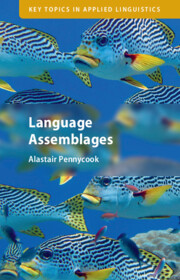Book contents
- Language Assemblages
- Key Topics in Applied Linguistics
- Language Assemblages
- Copyright page
- Contents
- Acknowledgements
- 1 Why Language Assemblages?
- 2 Language, Knowledge, Myths and Being
- 3 Structures and Practices
- 4 Linguistic, Semiotic and Sociomaterial Assemblages
- 5 Other Language Ontologies
- 6 Applied Linguistics as Practical Assemblage
- Suggested readings
- Glossary
- References
- Index
4 - Linguistic, Semiotic and Sociomaterial Assemblages
Published online by Cambridge University Press: 20 June 2024
- Language Assemblages
- Key Topics in Applied Linguistics
- Language Assemblages
- Copyright page
- Contents
- Acknowledgements
- 1 Why Language Assemblages?
- 2 Language, Knowledge, Myths and Being
- 3 Structures and Practices
- 4 Linguistic, Semiotic and Sociomaterial Assemblages
- 5 Other Language Ontologies
- 6 Applied Linguistics as Practical Assemblage
- Suggested readings
- Glossary
- References
- Index
Summary
There are three slightly different ways that language and languages can be considered in relation to the idea of assemblage: assemblages as combinations of linguistic items (language assemblages), assemblages as semiotic gatherings (semiotic assemblages) and assemblages as material arrangements that involve language (sociomaterial assemblages). Looking at language in terms of assemblages emphasizes the processes of communication as people draw on varied resources to make meaning. The notion of semiotic assemblages opens up ways of thinking that focus not so much on language use in particular contexts – as if languages pre-exist their instantiation in particular places – but rather on the ways in which particular assemblages of objects, linguistic resources and places come together. This is to approach language not as a pregiven or circumscribed entity but rather as something that is constantly being put together from a range of semiotic and resources. Sociomaterial assemblages similarly focus on things and places in relation to linguistic resources and consider language to be embodied, embedded and distributed, where language is not so much an abstract system of signs as changing sets of material relations.
- Type
- Chapter
- Information
- Language Assemblages , pp. 81 - 108Publisher: Cambridge University PressPrint publication year: 2024

